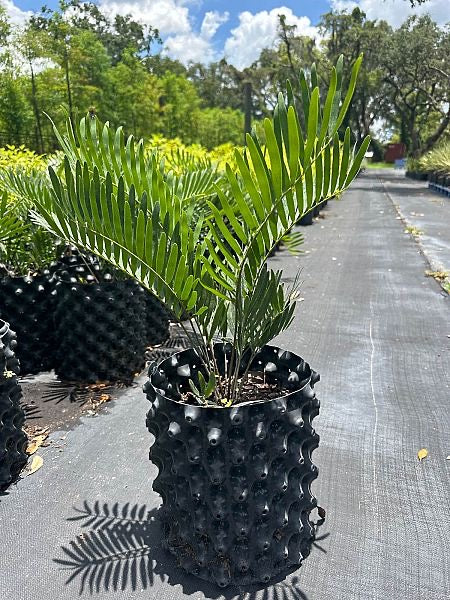
Coontie Palm
Coontie Palm (Zamia pumila)
Common Names: Coontie Palm, Florida Arrowroot, Seminole Bread, Wild Sago, Coontie Cycad.
Best Growing Environment: The Coontie Palm is not truly a palm, but a cycad – an ancient group of plants that predates the dinosaurs. Native to Florida and parts of the Caribbean, it thrives in sandy, well-draining soils. The Coontie Palm is adaptable to various soil types but prefers a slightly acidic pH.
Average Height: Despite its name, the Coontie Palm is relatively low-growing. Mature plants usually reach heights between 2 to 3 feet, but in optimal conditions, they might achieve up to 5 feet over many years.
Growth Rate: This plant is slow-growing. In its native environment, it may take years to reach its mature height.
Sun Requirements: Coontie Palm is versatile regarding sunlight. It can grow in full sun to partial shade. However, in extremely hot climates, it might appreciate some shade during the most intense sunlight hours.
Cold Hardiness: The Coontie Palm is relatively cold-hardy and can withstand temperatures as low as 15°F (-9°C). It's best suited for USDA zones 8b through 11.
Water Requirements: Once established, Coontie Palms are drought-tolerant. While young plants benefit from regular watering, mature plants can survive with minimal supplemental watering. As with most plants, it's essential to allow the soil to dry out between waterings to prevent root rot.
Fertilizing Guide: The Coontie Palm doesn't have high fertilizer needs. A balanced slow-release granular fertilizer applied once in the spring should suffice. Avoid using fertilizers with a high nitrogen content as this can make the plant more susceptible to pests.
Planting Guide: When planting, choose a spot with well-draining soil. Dig a hole about twice as wide as the root ball and the same depth. Place the plant into the hole, ensuring it's at the same depth as it was in its container. Backfill with soil, pressing firmly to eliminate any air pockets. Water thoroughly after planting.
USDA Zone: Coontie Palms are best suited for USDA zones 8b to 11. They can tolerate occasional frosts but should be protected during extended cold periods in the northernmost parts of its range.
The Coontie Palm is not only a historically significant plant – utilized by native tribes and early settlers for its starchy root – but also a wonderful addition to modern landscapes. Its feathery, fern-like leaves provide a tropical appearance, and its resilience to pests and harsh conditions make it an excellent choice for low-maintenance gardens. Moreover, it serves as the primary food source for the Atala butterfly caterpillar, helping to support local biodiversity.

